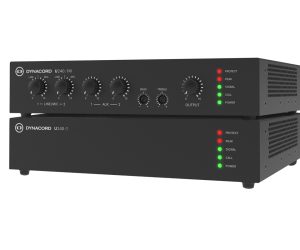
This Changes Everything
Harman buys AMX, then video-over-IP wunderkinds, SVSi, marketing it as SVSi by AMX, radically changing its business and the AV business in the process. Forget about the introduction of HDMI … this changes everything.
Text:/ Derek Powell
In 2007 Apple introduced a new product: the iPhone. It not only changed its business but forever altered the course of the personal computer and telecommunications industries. Millions of eyes migrated from monitors to mobile screens. Now iPhones represent the lion’s share of Apple’s income, far eclipsing its traditional desktop and even laptop products.
In 2015, AMX bought SVSi, which gave them a ready-made range of class-leading video-over-IP products. This makes AMX the first of the Big Three to take a real plunge into IP video distribution over the LAN as well as the WAN. Make no mistake, the conditions are ripe for audiovisual to migrate to the network. As that migration happens, it will eclipse many staple and familiar AMX product lines (switchers, extenders, controllers and more) and may forever change who designs, buys and installs audiovisual products.
BUT IS THIS NEW?
Let’s immediately acknowledge that SVSi (now ‘SVSi by AMX’) is not the only company with capable and well regarded video-over-IP products. For example, AV Asia Pacific reported on a big deployment of AdderLink video-over-LAN at the University of Sydney back in 2012, while the category of KVM (keyboard/video/mouse) extenders has a galaxy of suppliers in the IT and digital signage world with more video-over-IP products than you can count.
Waiting in the wings is AptoVision with its newly announced BlueRiver NT chipset – a packetised solution that claims to provide 4K/60Hz/4:4:4 transmission over Cat cable or fibre and switching using standard (though currently expensive) 10Gb IP switches. If you add to these the array of H264 encoders that were already available in the audiovisual arena from (amongst others) Crestron, Extron, Kramer, Gefen and AMX itself, you may wonder whether this is really news.
It is – and here’s why: Now, we have a major supplier touting a complete and capable new range of equipment that may, in time, replace most of its own flagship products. The ‘convergence’ of AV and IT is no longer something that might happen, it has happened. AMX, and its new parent Harman, know this and is shifting both its products and the way it goes to market to suit an IT-centric world.
So let’s jump on board and learn more about what AMX sees as the products of the future.
SVSi: FASTER THAN A SPEEDING BULLET
To get a better background, I spoke with Andy Whitehead – formerly SVSi CEO and now President of SVSi-AMX. I discovered the new network video products had an unexpected genesis.
“We started out building high-speed video cameras for manufacturing and packaging,” Andy recalled. “These could record 17,000 frames a second. It was the only device in the world that you could actually fire a bullet through the field of view and the camera would track its passage with high-speed video.”
SVSi sold those cameras up until around two years ago. But it noticed that many customers were more interested in the fact the camera had a network port, so it could transport stored video across their network – even to the other side of a large campus. From the level of enquiry, it was clear there was another market for this technology.
So SVSi took its very clever back-end of the high-speed camera, added analogue and digital inputs and created appliances that compressed and packetised high-resolution video, audio and control and enabled switching and routing across any standard data network to any appropriate destination. That product line matured over the intervening seven years, driven by demand in the US defence, government and corporate markets.
INDUSTRY VIEW
The Integrator:
Shane Cannon, Director of Sales & Marketing, Rutledge AV
INDUSTRY VIEW
The Consultant:
Peter Hunt, Group CEO, Hewshott International
1200 x 600 VIRTUAL MATRIX ANYONE?
The SVSi line includes videowall processors, a network recorder and even audio-over-IP products. But most interest has been in the N-series encoders and decoders that allow video, audio and control to be transported and switched by simply plugging into an existing network – bypassing the need for audiovisual matrix switchers and extenders.
There are three product families, which between them can cover any network link – local, LAN or WAN (including internet) transport. Andy described the N1000 range of products as an “in-room, or single-switch solution”. He claims that its high bandwidth of 800 Megabits per second (Mbps) and proprietary 4:2:2 colour-space compression provides near-lossless transport that is visually indistinguishable from wired Cat6 solutions such as HDBaseT. The advantage he stresses is that the SVSi encoders and decoders are true IP devices that can be part of the client’s existing gigabit data network, monitored and controlled using standard IT toolsets.
Expected to cause most interest is the N2000 line up, based on cinema-grade JPEG2000 4:2:2 compression. The compression is user-adjustable between 20 and 200Mbps, making them suitable to carry video, audio and control signals through multiple switches to anywhere on a typical LAN. These could prove enormously flexible solutions for meeting rooms, collaborative classrooms and in a range of overflow applications.
Rounding out the N-series is the N-3000. These products extend the reach of networked video all the way across the WAN and out onto the internet. The 3000 series use the H.264 compression codec and offers user-adjustable bit rates from an internet-friendly 50kbps right up to 10Mbps.
There’s no doubt that IP switching makes possible certain applications that otherwise would either be impossible or stratospherically expensive using conventional matrix switchers. SVSi’s largest installation to date is a 1200 x 600 virtual matrix for Juniper Networks’ massive new corporate headquarters in California. Video, audio and control to every projector, display, videoconference codec and DSP across 300-plus conference rooms in the campus is transported and switched on the network, with the savings from cabling alone reportedly paying for all the SVSi encoding equipment used on the job.
Not surprisingly, Andy Whitehead sees the future of audiovisual very much through an IT lens. He regards the migration of video onto the network as inevitable, just as voice-over-IP has almost completely replaced the corporate PABX. “IT has never lost a convergence war,” he insisted. “I don’t believe they are going to lose this one. It’s just a matter of time until network architectures are seen as the distribution platform of choice.”
MAKING THE TRADEOFF
While agreeing that networked video will play a huge role in all our futures, AMX head of product management for Australia & New Zealand Graham Barrett sees the new products as very much complementary to conventional audiovisual solutions. “SVSi has positioned itself as the product which bridges the two technologies, or the two worlds, of AV and IT,” Barrett says.
He believes the education market in Australia is perfectly positioned to take advantage of the lower cost and increased flexibility offered when the IP network takes on the role of switching and distributing video to multiple destinations.
“Most universities have a very large, robust and well maintained network,” Barrett explains. “Along with that, there are new forms of teaching, like collaborative classrooms, with the requirement to get video economically from lots of places to lots of other places. Many of those applications are ‘un-square’ – you’re talking about one presenter and lots of displays, or lots of student-generated input coming back to a single switching point at the lectern.
“So with a large distribution system based on, say DGX [the premium AMX hardware switcher] you are generally constrained by a square matrix – 8×8, 16×16, or whatever. The beauty with a network-based solution is it can be completely non-square – it can be 1:16, it can be 2:16, etc. And you’re not paying for the full 256 crosspoints – there’s a huge benefit there. In those situations, things like a small loss of video fidelity and latency are perfectly acceptable compromises.”
“”
IT has never lost a convergence war. I don’t believe they are going to lose this one. It’s just a matter of time until network architectures are seen as the distribution platform of choice.
Will AV-Over-IP Predominate?
Shane Cannon: “At this point in time there are applications for both circuit switching and packet switching. We’ve done plenty of packetised IPTV systems and digital signage systems that have sat on the network. And equally there have been other projects that require AV matrix switching. For example, in a large ‘live’’ venue facility, latency could be a deal breaker. However, saying that, a venue which records video from the event, and has overflow screens and digital signage may be able to accommodate a small amount of latency. And, in those circumstances, it’s possible that we could use a combination of circuit switching and video-over-IP.
Will AV-Over-IP Predominate?
Peter Hunt: Without a doubt, the answer is yes. The technology is there, the manufacturers are pushing this and integrators are gearing up quickly – it’s inevitable that it will happen. Users, however, are less predictable in this area because the more that’s on the network, the more network management there needs to be and this is where the issues lie. Add in security, possible input points for viruses and other Trojan software, what seems a simple and straight forward decision suddenly becomes complex and time-consuming. Combine this with important AV matters such as latency and quality of service, and it can all easily fall into the ‘too hard’ basket. Fortunately, these matters have been addressed and they are rapidly becoming a thing of the past and, like many of the world’s leading consultants, Hewshott has successfully managed implementation of entire solutions where the use of IP is well over 70% of the total solution by getting in early and having a seat at the table.
Selling Services vs Selling Gear
Shane Cannon: We’re proud to have worked on some great projects that require us to be at the forefront of technology and through that we sell our skills as much as we resell gear. We also have the Rutledge Care program which is an ongoing support service, so we’re already in the business of selling services. That said, clients are going to need specialist AV equipment. There are always going to be endpoints — screens, projectors — and source equipment, such as microphones and media servers. From there we could be leveraging off a specific AV network or a client network.
KNOW YOUR LIMITATIONS
While there is plenty of optimism about the benefits of using an existing data network to provide flexible and relatively inexpensive switching, no-one is shying away from the limitations either.
“You need to be fully informed of when you consider a networked distribution system,” Barrett points out. “The reality is that SVSi is, by its nature, a compressed video solution. So as with any compressed video solution you have loss of fidelity and in just about any compressed video solution you have latency. Now depending on the level of compression, the loss of fidelity and latency will be more or less important, relating directly to the type and level of compression,” Barrett continued.
Andy Whitehead is also quick to acknowledge the trade-off compression inevitably brings, noting it is important to understand the proper application for each of the N-series products. “Compression costs money; it adds latency; and degrades video quality, so an optimised system will only compress when it has to,” Andy notes. “But depending on your platform and bandwidth you absolutely have to compress for certain applications and the more you compress the further the reach of the video distribution system.”
Graham Barrett certainly sees a continuing role for dedicated audiovisual distribution and switching hardware alongside these new options. “When you compare a compressed solution to something like AMX’s Enova platform or Crestron’s 8G platform or the Extron XTP solution, all of those are designed to deliver content that is pixel perfect, with full resolution and zero latency. So in quality terms, that’s the starting point. The downside with those solutions though, is cost and flexibility.”
Diving a little deeper, it is crucial to consider the other benefits provided by a modern matrix switcher, such as end-to-end EDID management. SVSi has some quite capable EDID management integrated within the solution but acknowledge it is nowhere near as powerful as you will find in the case of the AMX Enova or competing hardware solutions. Right alongside EDID comes the need to consider scaling to cope with varying end points. There is certainly scaling capacity built into SVSi products, but the considerable investment AMX has made into Smart Scale technology in its DXLink product makes it a much more capable and flexible solution in demanding applications.
GAME CHANGER?
So could this be the iPhone moment for AMX? If video really does migrate to the network as quickly and completely as HDMI replaced VGA, then an awful lot of current traditional Pro-AV product is on shaky ground.
While acknowledging there are some mission critical applications that certainly warrant direct video and audio connections, it seems likely there are many really large installations (such as the Juniper Networks example cited earlier) and absolutely huge numbers of relatively simple meeting rooms and collaboration spaces will find the scalability and plug-and-play promise of video-over-IP irresistible.
Matrix switchers, both large and small could disappear altogether and the vast range of HDMI extenders won’t be needed either. We may even find that encoders start to be built-in to many source components. Any PC-based equipment or networked storage devices are prime candidates to have an extra network port replace their HDMI socket as the primary video and audio output. On that score, we are likely to see many more displays plugging directly into a network feed (smart TVs already do!) just as many projectors are already appearing with direct HDBaseT inputs.
IP VIDEO VERSUS HDBASET
Despite using the same blue Cat ‘x’ cables, video distribution over IP is fundamentally different from HDBaseT, something which causes customers persistent confusion.
Both systems carry video, audio and control signals but HDBaseT cannot travel across a standard data network. HDBaseT is a continuous digital signal that must use dedicated cables from an HDBaseT transmitter directly to another HDBaseT device – either a receiver or an HDBaseT capable matrix switcher. The audiovisual distribution in a facility using HDBaseT is completely separate from the data network.
Video-over-IP travels across the same data network that provides email, file transfers and internet access. Once encoded, the video, audio and control data is split into chunks (called ‘packets’) which are routed over existing data switches and routers to their final destination. There are no dedicated cables just for video. Conventional audiovisual-style matrix switchers are generally not needed and not used. At the destination, a decoder converts and re-assembles the IP packets back to continuous baseband video, audio and control signals for input to the display.
Does AV-over-IP Make it Easier or Harder for a Systems Integrator?
Shane Cannon: There are a number of disciplines you need to be across to create an exceptional AV experience. You’ve got your regular AV product knowledge, then you’ve got to know your acoustics, lighting, environmental, room layout; then apply the AV gear to the task of echo cancellation, control systems and the like, and overlay that with packet switching or IP streaming; solution-architect that as well. Pulling all that together and having the right people to deliver on all those pillars of a great AV solution requires us to have a specialised and committed team.
Does AV-over-IP Make it Easier for Electrical or IT to Cut AV’s Lunch?
Peter Hunt: The answer is: it probably won’t help. And this is the bugbear of almost every professional in the AV industry. This industry is full of very skilled individuals and organisations worldwide who are passionate about the user experience – visually and aurally. Others from allied fields get into this space with no pedigree or depth of knowledge in the entire process of delivering a solution that meets their clients’ needs. There are more than 100 types of microphones and ceiling speakers out there, and easily the same combinations of screens and projectors. Which one is correct in what situation, and why? Has anyone examined the acoustics and lighting? AV is to technology as what architecture is to building sites, and I find it disturbing at best that a sizeable investment by a client is chanced with advice from non-core specialists, who invariably deliver a mediocre solution, usually at a cost that could have created a much better user experience. No other area of industry is implemented without the right expertise advising, and there are too many people that jump on the AV bandwagon. All this does is damage our integrity, and in my view is a major contributor to the fragility of AV’s future.
Got IT on Staff?
Shane Cannon: We made sure early on that we had IT skill sets in the business. Obviously you have to make sure you keep people skilled up. But we’ve got some great IT skills in our team which allows us to deliver on the projects and the whole team is across it.
Got IT on Staff?
Peter Hunt: Hewshott has full-time, in-house IT consultants that design and deliver network related strategies and architecture. When combined with our AV consultants, we are making significant inroads into projects where the seamless use of AV over networks is paramount to the final outcome.
HOW LONG HAVE WE GOT?
Pundits from both sides of the AV/IT fence at least agree the winds of change are beginning to howl. But taking a quick straw poll of the industry, I found (as you might expect) a diversity of opinion as to when the change will arrive. Some operators of very capable data networks have said privately that they will be testing network video product as soon as they can get it and don’t intend to be investing in audiovisual matrix switchers ever again. Others are more cautious, agreeing that streaming video for motion pictures is a no-brainer but pointing out that content even as mundane as spreadsheets can quickly degrade under even light compression. For them, HDBaseT still has plenty of legs.
The official line from AMX with its new owner Harman, could best be summed up as “Keep Calm & Carry On”. Here’s what head office wrote when I asked them about the potential for networked video to supplant much of the traditional audiovisual product line.
“We do see a significant trend towards the delivery of video-over-IP networks and the SVSi product line and development team positions us well for the future, however, the tipping point for technology trends sometimes takes longer than we think it will. Having both distribution technologies in the portfolio allows us to effectively meet our customer’s needs both today and into tomorrow.”
It’s a fair point and I don’t want to be seen as some kind of audiovisual prophet of doom. However, AMX has just invested heavily into this each-way bet and my guess is that others will be quick to follow suit. When that happens, the tipping point might shift rather rapidly.
The point is that every audiovisual consultant, designer and buyer that I spoke to is now keeping a very close eye on video-over-IP products.
We are certainly not yet at a situation where video over the network is the right answer for every – or even most – new designs. And it’s really important to understand up front that there are compromises – both the obvious ones of quality and latency but also the less obvious limitations where it comes to sophisticated EDID management and the subtleties of scaling – and that’s without even mentioning HDCP!
But from 2015, for each new corporate, education or even residential audiovisual system, every designer must now consider whether video-over-IP is the right option.
That’s what’s new. That’s what’s important. We are a long way from the end game, and there’s going to be plenty of new product to wrestle with from all directions. But AMX’s decision to embrace disruptive technology gives all audiovisual professionals new opportunities – and new challenges.















RESPONSES